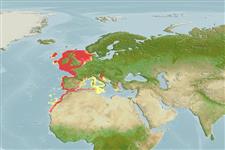Ikan bertulang rawan (sharks and rays) >
Rajiformes (Skates and rays) >
Rajidae (Skates)
Etymology: Raja: Latin, raja, -ae = a sting ray (Raja sp.) (Ref. 45335).
Environment: milieu / climate zone / kisaran kedalaman / distribution range
Ekologi
laut dasar (demersal); kisaran kedalaman 10 - 380 m (Ref. 6808). Temperate; 60°N - 22°N, 18°W - 24°E
Eastern Atlantic: Shetland Islands to Morocco, Rio de Oro (Western Sahara), and Madeira.
Length at first maturity / Size / Weight / umur
Kematangan: Lm 90.2, range 60 - ? cm
Max length : 120 cm TL jantan/; (Ref. 41333); 125.0 cm TL (female); Berat maksimum terpublikasi: 14.3 kg (Ref. 40637)
Duri punggung (Keseluruhan (total)) : 0; Duri dubur: 0. Upper surface wholly prickly, except in juveniles; underside only prickly along front margins of disc; orbital thorns separate; a regular median row of 40-45 thorns in juveniles and adult females, interrupted on back in males; 60-90 tooth rows; upper surface ochre, with numerous small dark spots to margins of disc, underside white (Ref. 3167).
Body shape (shape guide): other; Cross section: flattened.
Found on sand and sand-rock bottoms (Ref. 6808). Feed on all kinds of benthic animals (Ref. 3167). Oviparous. Distinct pairing with embrace. Young may tend to follow large objects, such as their mother (Ref. 205). Eggs are oblong capsules with stiff pointed horns at the corners deposited in sandy or muddy flats (Ref. 205). Egg capsules are 10.0-14.3 cm long and 5.8-9.0 cm wide (Ref. 41250). About 40-90 eggs are laid per individual every year (Ref. 41250).
Oviparous, paired eggs are laid. Embryos feed solely on yolk (Ref. 50449). Spawning mainly from February to August with at least 30 egg-cases laid (Ref. 3167). Distinct pairing with embrace. Young may tend to follow large objects, such as their mother (Ref. 205).
McEachran, J.D. and K.A. Dunn, 1998. Phylogenetic analysis of skates, a morphologically conservative clade of elasmobranchs (Chondrichthyes: Rajidae). Copeia 1998(2):271-290. (Ref. 27314)
Status IUCN Red List (Ref. 130435: Version 2025-1)
ancaman kepada manusia
Harmless
penggunaan manusia
Perikanan: nilai komersial kecil; Ikan buruan: ya
Alat, peralatan
laporan khas
muat turun XML
Sumber internet
Estimates based on models
Preferred temperature (Acuan
123201): 7.1 - 16.2, mean 10.3 °C (based on 462 cells).
Phylogenetic diversity index (Acuan
82804): PD
50 = 0.5000 [Uniqueness, from 0.5 = low to 2.0 = high].
Bayesian length-weight: a=0.00224 (0.00144 - 0.00348), b=3.27 (3.15 - 3.39), in cm total length, based on LWR estimates for this species & Genus-body shape (Ref.
93245).
Trophic level (Acuan
69278): 3.8 ±0.61 se; based on food items.
Daya lenting (Acuan
120179): Rendah, Waktu penggandaan populasi minimum 4.5 - 14 tahun (K=0.12-0.19; tmax=15; Fec=40).
Prior r = 0.20, 95% CL = 0.13 - 0.30, Based on 1 full stock assessment.
Fishing Vulnerability (Ref.
59153): High to very high vulnerability (65 of 100).
🛈
Climate Vulnerability (Ref.
125649): High vulnerability (61 of 100).
🛈
Nutrients (Ref.
124155): Calcium = 4.69 [0.73, 84.95] mg/100g; Iron = 0.26 [0.02, 2.99] mg/100g; Protein = 16.7 [13.9, 19.0] %; Omega3 = 0.869 [0.349, 2.113] g/100g; Selenium = 14.8 [3.0, 71.4] μg/100g; VitaminA = 7.7 [0.6, 90.3] μg/100g; Zinc = 0.31 [0.02, 3.43] mg/100g (wet weight);
